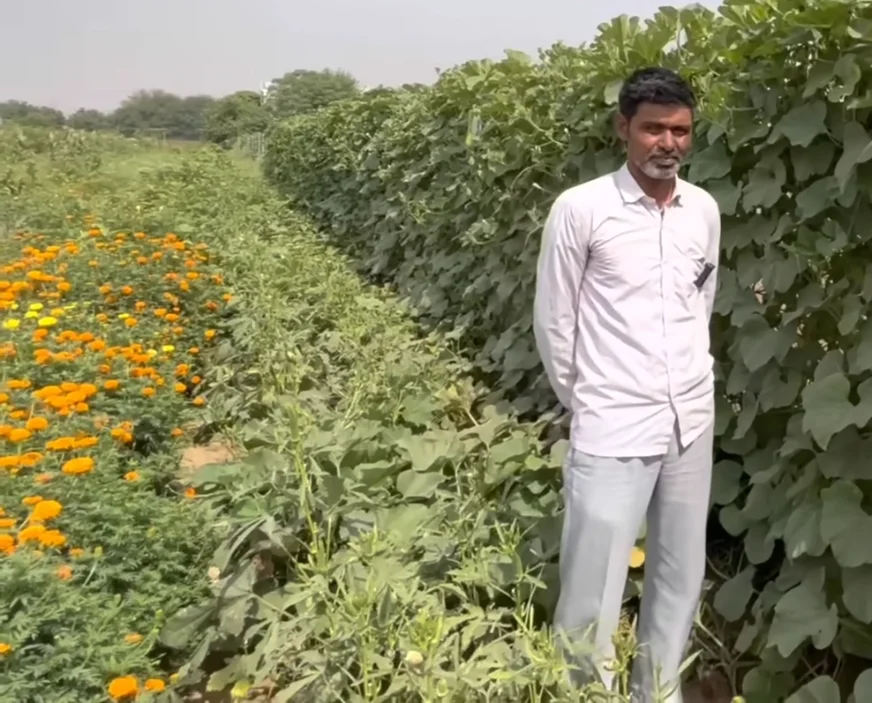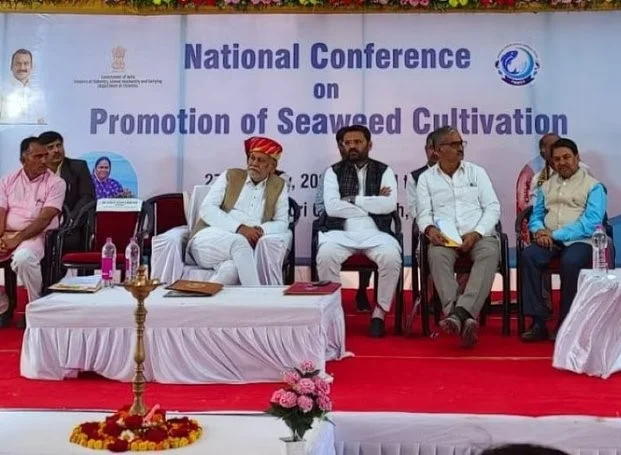Meet Chandra, an extraordinary farmer from Seetadi village, Tehsil Tijara, Alwar district, who has redefined agricultural success with his innovative intercropping model. Unlike traditional farming, Chandra doesn’t just cultivate his field; he transforms every inch of his 5-acre land into a lucrative source of income. His unique approach, planting various vine crops like bottle gourd and bitter gourd vertically on cables along the field border, has made him a trailblazer in the farming community.
Chandra’s tractor-driven cultivation and diverse crop selection have not only surpassed conventional earnings but also set a new standard. The financial triumph is evident as he shares that his model generates around Rs.10 Lakh per acre. Join Chandra on a journey inside his fields, where he showcases the profitability of this unconventional farming technique, promising even those with limited land the opportunity to earn significant profits.
Use of Intercropping
Chandra’s farming success shines a spotlight on the practice of intercropping, a method that involves cultivating multiple crops together. Unlike conventional farming, where one crop dominates, intercropping brings diversity to the field. Chandra’s choice to embrace intercropping not only diversifies his harvest but also transforms his farm into a more sustainable and profitable venture.

Intercropping, as seen in Chandra’s fields, offers several advantages. It improves soil fertility, reduces pest issues, and maximizes land use. Chandra’s story inspires other farmers to consider innovative approaches that enhance productivity and contribute to environmental well-being.
In the upcoming sections, we explore the specific crops Chandra has chosen, uncovering the synergy between them and understanding how this approach has led to his remarkable financial success. Join us as we step into Chandra’s fields, where a blend of crops creates a thriving and prosperous agricultural environment.
Crop Selection and Planning
Chandra’s meticulous approach to crop selection and planning has been pivotal in the success of his intercropping venture. Diversifying from traditional mono-cropping, he strategically chooses crops that complement each other in terms of growth patterns, nutrient requirements, and market demand.
On the border of his field, Chandra vertically plants vine crops like bottle gourd, bitter gourd, and pumpkin on cables. This unique approach not only optimizes space but also maximizes profits. The border crops alone contribute significantly to his impressive earnings.
Within the field, Chandra has carefully chosen a mix of crops, each contributing to the overall synergy. Okra, a high-demand vegetable, is a prominent choice. The careful planning ensures a continuous harvest, allowing Chandra to sell approximately 40% of his okra yield, generating substantial income.
The success of intercropping lies not just in planting multiple crops but in understanding their compatibility.
In this thriving intercropping model, Chandra dedicates several beds to the cultivation of ladyfinger. Having already sold ladyfinger worth Rs 50,000, the season for this nutritious vegetable is expected to continue for another 1.5 months. Nestled next to a guava bed, Marigold flowers flourish, selling at Rs 40/kg. Beyond their vibrant beauty, these flowers play a crucial role in preventing nematode attacks on guava plants. Chandra successfully earns an impressive 1-1.5 lakh per acre from the Marigold cultivation. Another bed hosts

Achari Mirchi (green chili), resistant to the notorious curl virus that affects traditional chili crops. This resilient crop promises a robust harvest, and Chandra estimates an income of approximately ₹1 lakh per bed. In Karnal, he has already harvested 10 to 12 quintals, showcasing the success of this intercropping venture.

Moving on to pumpkins, each weighing around 20 kilograms, Chandra adopts a strategic approach. If market rates are unfavorable, he stores the pumpkins for the summer when prices surge to ₹15-20 per kilogram, translating to an estimated ₹350-400 per piece. Notably, the pumpkin crop remains resilient against diseases. Watermelon, specifically the Sagar King variety, graces approximately 10 to 12 beds in this intercropping setup. Each bed yields an impressive ₹1 lakh in income. Tomatoes adorn 10 to 15 beds in this diverse model. Despite lower market rates, the abundance of organic tomatoes showcases the success of this sustainable approach to farming. Tinda (Indian round gourd) finds a place in Chandra’s cultivation, with sales already reaching Rs 35,000. Planted across 5-6 beds, this unique vegetable adds variety to his intercropping venture.

Additionally, Chandra tends to beds of corn and mangoes. The mango varieties include Arunika and Ambika, with beds of guava featuring Hissar Safeda and Taiwan Pink. The combined income from mangoes and guavas amounts to an impressive 4-5 lakh per acre annually.
Sustainable and Ecofriendly approach
Chandra’s commitment to sustainable and eco-friendly practices is at the core of his agricultural philosophy. Embracing a harmonious approach to farming, he has woven environmentally conscious practices into the fabric of his intercropping model.
One notable aspect of Chandra’s sustainability initiatives is his dedication to organic farming. The produce from his fields, be it the abundant tomatoes or the various fruits and vegetables, is cultivated without the use of harmful chemicals. This not only ensures the health and well-being of consumers but also contributes to preserving the natural balance of the ecosystem.

Incorporating diverse crops in his intercropping model is another key element of Chandra’s sustainable practices. This method not only optimizes land use but also minimizes the risk of pests and diseases, reducing the need for chemical interventions. The synergy between different crops promotes a healthier environment, fostering biodiversity within the agricultural landscape.
Water conservation holds a crucial place in Chandra’s eco-friendly approach. Implementing efficient irrigation methods, he ensures that water is utilized judiciously, minimizing wastage. By adopting water-efficient practices, he not only conserves a precious resource but also sets an example for responsible water management in agriculture.
Chandra’s commitment to sustainable practices extends beyond the field. From waste management to energy conservation, every aspect of his farming venture is designed with a mindful approach. This holistic commitment to eco-friendly practices not only safeguards the environment but also contributes to building a resilient and sustainable agricultural model for the future.
Impact on community
Chandra’s innovative intercropping model has had a profound impact on the local community, serving as a beacon of inspiration for fellow farmers. The success of his venture has not only elevated his economic standing but has also created a ripple effect in the community.
Local farmers, witnessing the financial success of Chandra’s diverse crops, are now open to exploring alternative agricultural models. Chandra’s willingness to share his knowledge and experiences has become a valuable resource for neighboring farmers, fostering a spirit of collaboration and learning.









